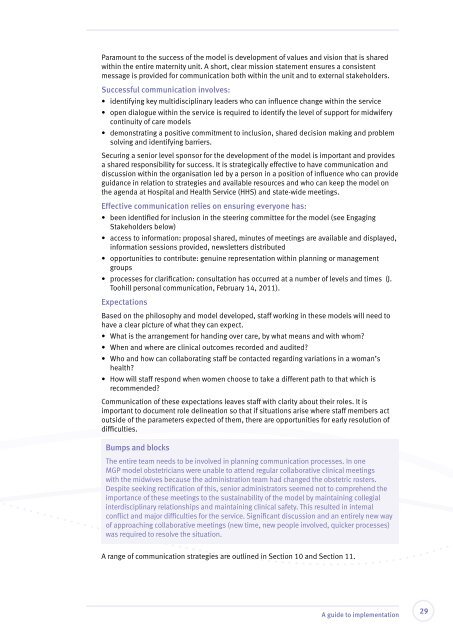Delivering continuity of midwifery care to Queensland women
Delivering continuity of midwifery care to Queensland women
Delivering continuity of midwifery care to Queensland women
Create successful ePaper yourself
Turn your PDF publications into a flip-book with our unique Google optimized e-Paper software.
Paramount <strong>to</strong> the success <strong>of</strong> the model is development <strong>of</strong> values and vision that is shared<br />
within the entire maternity unit. A short, clear mission statement ensures a consistent<br />
message is provided for communication both within the unit and <strong>to</strong> external stakeholders.<br />
Successful communication involves:<br />
• identifying key multidisciplinary leaders who can influence change within the service<br />
• open dialogue within the service is required <strong>to</strong> identify the level <strong>of</strong> support for <strong>midwifery</strong><br />
<strong>continuity</strong> <strong>of</strong> <strong>care</strong> models<br />
• demonstrating a positive commitment <strong>to</strong> inclusion, shared decision making and problem<br />
solving and identifying barriers.<br />
Securing a senior level sponsor for the development <strong>of</strong> the model is important and provides<br />
a shared responsibility for success. It is strategically effective <strong>to</strong> have communication and<br />
discussion within the organisation led by a person in a position <strong>of</strong> influence who can provide<br />
guidance in relation <strong>to</strong> strategies and available resources and who can keep the model on<br />
the agenda at Hospital and Health Service (HHS) and state-wide meetings.<br />
Effective communication relies on ensuring everyone has:<br />
• been identified for inclusion in the steering committee for the model (see Engaging<br />
Stakeholders below)<br />
• access <strong>to</strong> information: proposal shared, minutes <strong>of</strong> meetings are available and displayed,<br />
information sessions provided, newsletters distributed<br />
• opportunities <strong>to</strong> contribute: genuine representation within planning or management<br />
groups<br />
• processes for clarification: consultation has occurred at a number <strong>of</strong> levels and times (J.<br />
Toohill personal communication, February 14, 2011).<br />
Expectations<br />
Based on the philosophy and model developed, staff working in these models will need <strong>to</strong><br />
have a clear picture <strong>of</strong> what they can expect.<br />
• What is the arrangement for handing over <strong>care</strong>, by what means and with whom<br />
• When and where are clinical outcomes recorded and audited<br />
• Who and how can collaborating staff be contacted regarding variations in a woman’s<br />
health<br />
• How will staff respond when <strong>women</strong> choose <strong>to</strong> take a different path <strong>to</strong> that which is<br />
recommended<br />
Communication <strong>of</strong> these expectations leaves staff with clarity about their roles. It is<br />
important <strong>to</strong> document role delineation so that if situations arise where staff members act<br />
outside <strong>of</strong> the parameters expected <strong>of</strong> them, there are opportunities for early resolution <strong>of</strong><br />
difficulties.<br />
Bumps and blocks<br />
The entire team needs <strong>to</strong> be involved in planning communication processes. In one<br />
MGP model obstetricians were unable <strong>to</strong> attend regular collaborative clinical meetings<br />
with the midwives because the administration team had changed the obstetric rosters.<br />
Despite seeking rectification <strong>of</strong> this, senior administra<strong>to</strong>rs seemed not <strong>to</strong> comprehend the<br />
importance <strong>of</strong> these meetings <strong>to</strong> the sustainability <strong>of</strong> the model by maintaining collegial<br />
interdisciplinary relationships and maintaining clinical safety. This resulted in internal<br />
conflict and major difficulties for the service. Significant discussion and an entirely new way<br />
<strong>of</strong> approaching collaborative meetings (new time, new people involved, quicker processes)<br />
was required <strong>to</strong> resolve the situation.<br />
A range <strong>of</strong> communication strategies are outlined in Section 10 and Section 11.<br />
A guide <strong>to</strong> implementation<br />
29
















